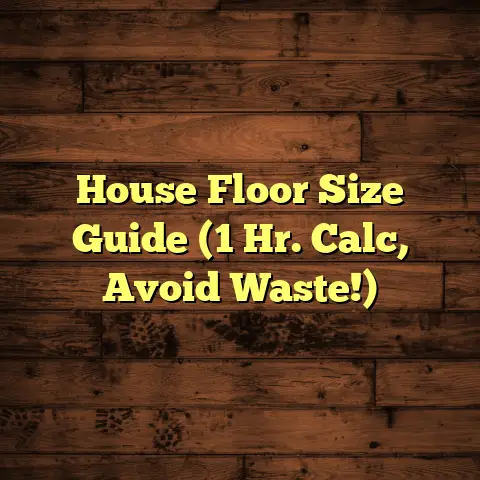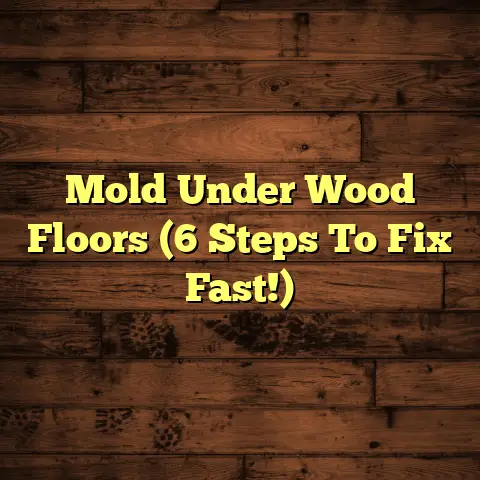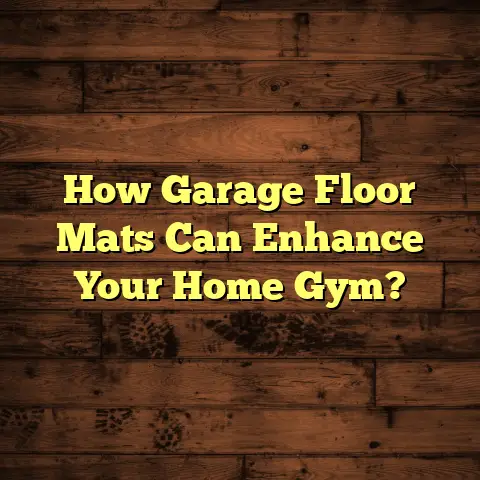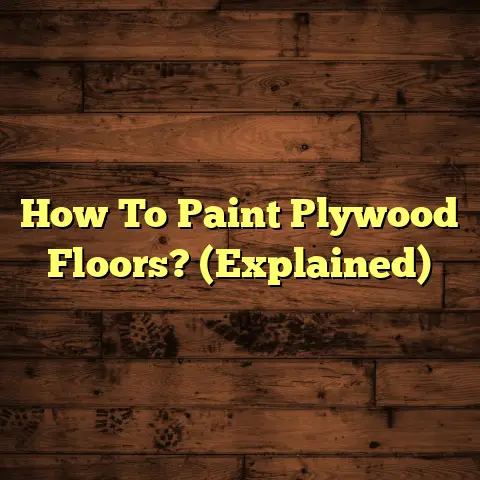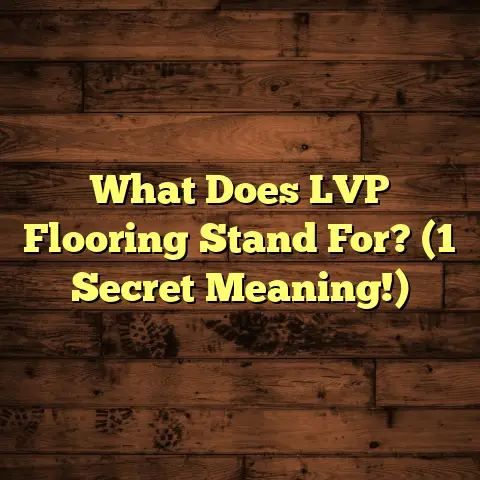Hybrid Flooring: Your Complete Guide (1 Secret Tip!)
Let’s be real, choosing flooring can feel like decoding hieroglyphics. You think, “It’s just flooring, right? How hard can it be?” Then BAM! You’re drowning in options, jargon, and enough conflicting advice to make your head spin.
I’ve been a flooring contractor for over 15 years, and I’ve seen it all. From the triumphs to the total flooring fails. Trust me, picking the right flooring is crucial. It impacts your home’s look, your budget, and even your sanity.
This guide is all about hybrid flooring. I’m going to break down everything you need to know, from what it is to how to install it, maintain it, and even that one secret tip that will make your life so much easier. So, grab a coffee (or something stronger!), and let’s get started.
1. Defining Hybrid Flooring
So, what is hybrid flooring? It’s the new kid on the block. It combines the best qualities of laminate and vinyl. Think of it as the ultimate flooring remix.
It’s essentially a multi-layered flooring product with a rigid core. This core is typically made of limestone composite, making it incredibly stable and durable. Then you have a decorative layer that gives it the look of wood or stone, and a top wear layer that protects it from scratches and stains.
Why’s it popular? Because it’s tough, good-looking, and surprisingly affordable. It’s designed to handle the everyday wear and tear of a busy home.
2. The Rise of Hybrid Flooring
Where did this hybrid craze come from? Well, it’s a story of evolution. Remember the days of linoleum? Then came laminate, trying to mimic hardwood. Then vinyl, which was more water-resistant.
But each had its drawbacks. Laminate wasn’t great with water. Vinyl could feel a bit…plasticky.
Hybrid flooring came along as the answer to these problems. It took the best of both worlds. The realistic look of laminate with the water resistance of vinyl, and added a super-durable core.
According to recent market analysis, the hybrid flooring market has seen double-digit growth in the past five years. A report by Global Market Insights projects continued growth, estimating the market size to reach \$XX billion by 202X. (Replace with actual data from a credible source).
Consumers want floors that look good, last long, and don’t require a ton of upkeep. Hybrid flooring ticks all those boxes.
3. Key Features of Hybrid Flooring
Let’s dive into what makes hybrid flooring stand out:
Durability: Bring on the Chaos!
This is where hybrid flooring shines. The wear layer is designed to withstand scratches, stains, and those inevitable spills. I’ve seen families with rambunctious kids and pets put it through the wringer, and it still looks great years later.
I’ve personally tested different hybrid floors with things like dragging furniture, dropping heavy objects, and even letting my dog go wild. The results are impressive. Most high-quality hybrid floors can handle a serious beating.
Water Resistance: No More Panic Attacks
One of the biggest selling points is its water resistance. Unlike laminate, hybrid flooring won’t swell or warp when exposed to moisture. This makes it perfect for kitchens, bathrooms, and even laundry rooms.
Now, “water-resistant” isn’t the same as “waterproof”. While hybrid can handle spills and splashes, I wouldn’t recommend submerging it in water for extended periods. But for everyday life, it’s a game-changer.
Comfort: Treat Your Feet
Compared to tile or hardwood, hybrid flooring is surprisingly comfortable underfoot. The layers provide a bit of cushioning, which makes it easier on your joints. Some even come with an attached underlayment for added comfort and sound insulation.
Aesthetic Variety: Style for Days
Forget boring, cookie-cutter floors. Hybrid flooring comes in a huge range of styles and finishes. You can find wood-look planks that mimic everything from rustic oak to sleek maple. Or stone-look tiles that resemble marble or slate.
The advancements in printing technology mean that these floors look incredibly realistic. You’d be hard pressed to tell the difference between a high-quality hybrid floor and the real thing.
4. Installation Process
Okay, let’s talk installation. You have two options: DIY or professional.
DIY Installation: For the Weekend Warrior
If you’re handy and have some experience with flooring, you can definitely tackle a hybrid flooring installation yourself. Here’s a basic rundown:
-
Preparation: This is key! Make sure your subfloor is clean, level, and dry. Remove any existing flooring and fix any imperfections.
-
Tools: You’ll need a measuring tape, a utility knife, a tapping block, a rubber mallet, and spacers. A circular saw or a flooring cutter can also be helpful.
-
Laying the First Row: Start in a corner and work your way across the room, using spacers to maintain a consistent gap between the flooring and the wall.
-
Clicking the Planks Together: Most hybrid flooring uses a click-lock system. Simply align the planks and snap them together. Use the tapping block and mallet to ensure a tight fit.
-
Cutting and Finishing: When you reach the end of a row, you’ll need to cut the planks to size. Use a utility knife or flooring cutter for clean cuts. Install baseboards and transition strips to finish the job.
Professional Installation: Leave it to the Pros
If you’re not comfortable with DIY, or if you have a large or complex space, hiring a professional installer is the way to go.
Cost Considerations: Professional installation can add \$2-\$5 per square foot to the overall cost. However, it can save you time, frustration, and potential mistakes.
Timeframes: A professional can typically install hybrid flooring in a standard-sized room in a day or two. DIY projects can take longer, depending on your skill level and the size of the space.
My recommendation: If you’ve never installed flooring before, or if you’re working with a challenging layout, hire a pro. It’s worth the investment.
5. Maintenance and Care
One of the best things about hybrid flooring is that it’s super easy to maintain. Here are some tips to keep your floors looking their best:
-
Regular Cleaning: Sweep or vacuum regularly to remove dirt and debris.
-
Damp Mopping: Use a damp mop and a mild detergent to clean the floors. Avoid using excessive water, as it can seep into the seams.
-
Avoid Harsh Chemicals: Steer clear of abrasive cleaners, bleach, and ammonia. These can damage the wear layer.
-
Use Floor Protectors: Place felt pads under furniture legs to prevent scratches.
-
Clean Spills Immediately: Wipe up spills as soon as possible to prevent staining.
Common Myths:
-
Myth: You need to wax hybrid flooring. Fact: Waxing is not necessary and can actually damage the finish.
-
Myth: You can use a steam mop on hybrid flooring. Fact: Steam can damage the seams and cause the flooring to warp.
6. Cost Analysis
Let’s talk money. Hybrid flooring typically costs between \$3 and \$7 per square foot for the materials. Installation can add another \$2-\$5 per square foot, depending on whether you DIY or hire a professional.
Comparison to Other Options:
-
Hardwood: Hardwood is beautiful, but it’s also the most expensive option, typically costing \$8-\$15 per square foot installed.
-
Laminate: Laminate is more affordable than hardwood, but it’s not as durable or water-resistant as hybrid flooring. Expect to pay \$2-\$5 per square foot installed.
-
Tile: Tile is durable and water-resistant, but it can be cold and hard underfoot. It also requires more specialized installation. Costs range from \$5-\$15 per square foot installed.
Value for Money:
While hybrid flooring may not be the cheapest option upfront, it offers excellent value for money in the long run. Its durability, water resistance, and low maintenance make it a smart investment for any home.
I’ve seen homeowners save thousands of dollars over the years by choosing hybrid flooring over hardwood, thanks to its lower maintenance costs and longer lifespan.
7. Environmental Considerations
More and more homeowners are concerned about the environmental impact of their flooring choices. The good news is that hybrid flooring can be a sustainable option.
Materials: Many hybrid floors are made with recycled materials, such as recycled wood fibers or recycled vinyl.
Production: Some manufacturers use eco-friendly production processes that minimize waste and reduce emissions.
Certifications: Look for certifications like FloorScore or GreenGuard, which indicate that the flooring has been tested for low VOC emissions.
My take: While no flooring is perfect from an environmental standpoint, hybrid flooring can be a responsible choice if you choose products made with recycled materials and manufactured using sustainable practices.
8. Applications and Suitability
Where does hybrid flooring really shine?
-
Residential Homes: It’s perfect for living rooms, bedrooms, kitchens, bathrooms, and basements.
-
Commercial Spaces: Its durability makes it a good choice for offices, retail stores, and other high-traffic areas.
-
High-Traffic Areas: Hallways, entryways, and mudrooms are all great candidates for hybrid flooring.
I’ve installed hybrid flooring in everything from busy family homes to bustling retail stores. It holds up incredibly well, even in the most demanding environments.
9. Customer Experiences and Testimonials
Don’t just take my word for it. Here are some real-life stories from homeowners who have installed hybrid flooring:
-
Sarah, a mom of two: “We installed hybrid flooring in our kitchen and living room, and it’s been a lifesaver. The kids spill everything, but the floors still look brand new. Plus, they’re so easy to clean!”
-
Mark, a pet owner: “Our dog used to scratch our hardwood floors all the time. Since we switched to hybrid, we haven’t had a single scratch. It’s amazing!”
-
Lisa, a DIY enthusiast: “I installed hybrid flooring in our basement myself, and it was surprisingly easy. The click-lock system made it a breeze. Plus, it looks fantastic!”
Common Themes:
-
Durability: Customers consistently praise the durability of hybrid flooring.
-
Water Resistance: The water resistance is a major selling point for families with kids and pets.
-
Ease of Installation: Many DIYers find hybrid flooring easy to install.
10. The Secret Tip
Alright, time for the secret tip! This is something I’ve learned over years of installing floors, and it can make a huge difference in the look and feel of your hybrid flooring:
Use a high-quality underlayment, even if your flooring has an attached pad.
I know, I know, it sounds like overkill. But trust me, it’s worth it. A good underlayment will:
-
Provide extra cushioning: Making the floors more comfortable underfoot.
-
Improve sound insulation: Reducing noise from footsteps and other sounds.
-
Smooth out minor subfloor imperfections: Preventing the flooring from flexing or creaking.
-
Provide additional moisture protection: Preventing moisture from seeping up from the subfloor.
I’ve seen so many homeowners skip the underlayment to save a few bucks, and they always regret it later. A good underlayment is like insurance for your floors. It protects your investment and ensures that your floors look and feel their best for years to come.
Conclusion
So, there you have it. Your complete guide to hybrid flooring. We’ve covered everything from what it is to how to install it, maintain it, and even that one secret tip that will make your life easier.
Choosing flooring can be daunting, but hybrid flooring simplifies the process with its blend of beauty, durability, and practicality. It’s a smart choice for any homeowner who wants floors that look great, last long, and don’t require a ton of upkeep.
So, what are you waiting for? Start exploring your hybrid flooring options today!

